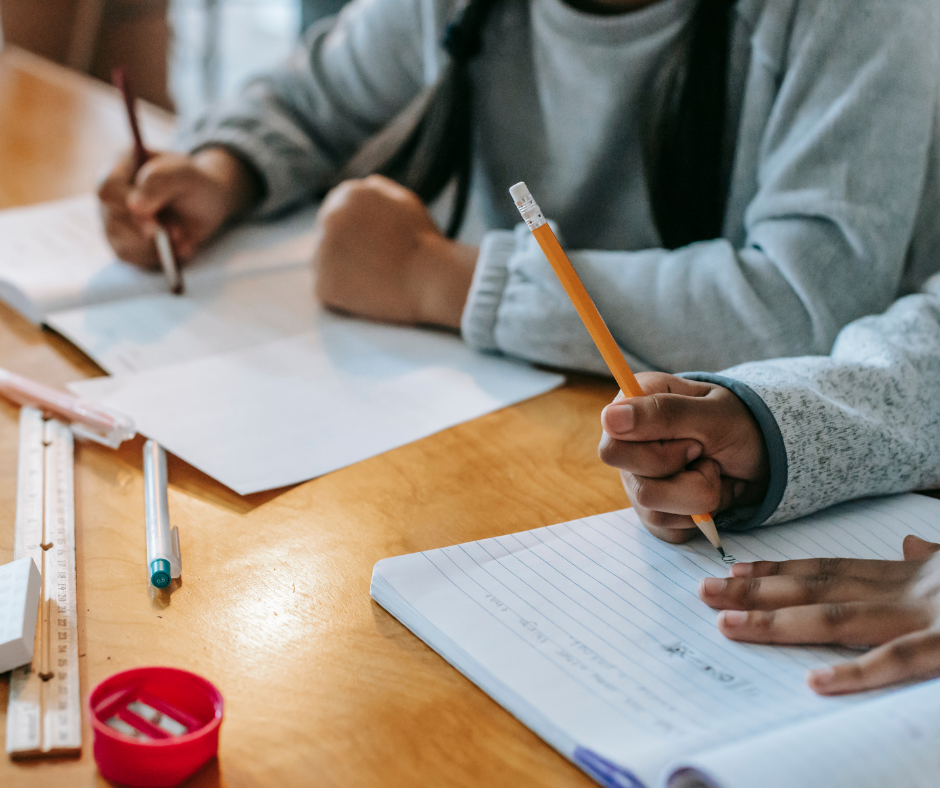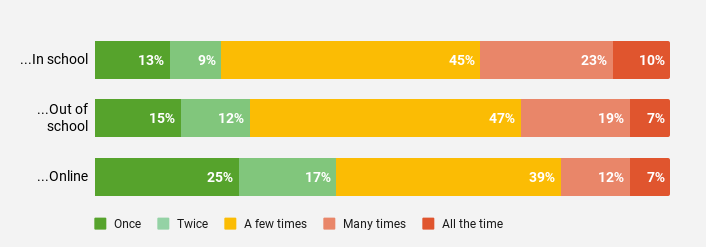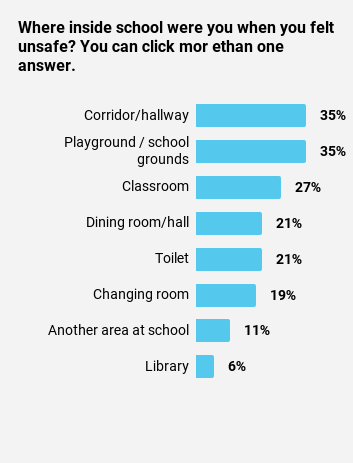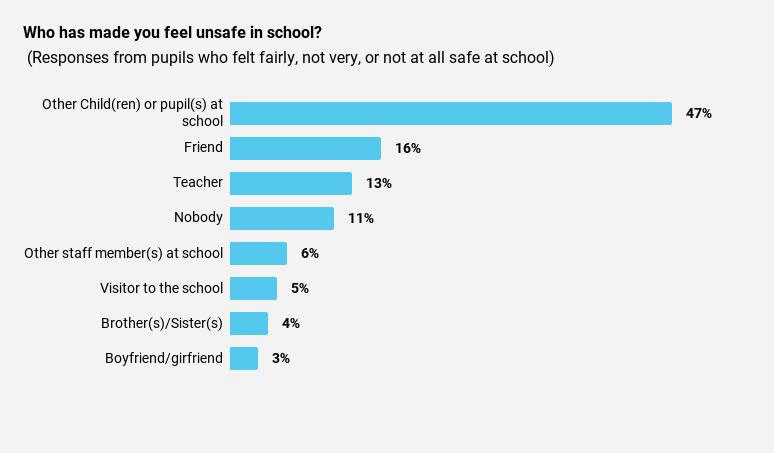17 May, 2023
Where do pupils feel safest?
Where do pupils feel safest & what contributes to their perceptions?
Safeguarding Children and Young People – Where Do Our Pupils Feel Safest?
Edurio has worked in partnership with The Key over the last ten months to develop, build and conduct one of the largest safeguarding surveys for schools and trusts in the UK. We looked at current policies and guidance on safeguarding children and young people, such as KCSIE 2022 and government guidance for RSE and PSHE, to develop our survey topics. The survey explores students’ views of safety and safeguarding matters. We launched the survey in October 2022, and our report summarises the experience of around 70,000 pupils who participated between 3rd October and 11th November 2022 from 373 schools and 41 Trusts.
The review examines the largest dataset to date of LGBTQ+ and non-binary student views on safeguarding. Our survey explores students’ perceptions of readiness to learn, access to help, feelings of safety, treatment of others and the curriculum elements relating to safeguarding children and young people.
One of the notable topics within this survey we were keen to explore was how safe students feel in different environments. Our survey explores students’ feelings of safety in multiple settings, the frequency of feeling unsafe, and whether pupils were missing school as a result of these feelings directly. The findings from our survey were recently published at the CST Safeguarding Conference on the 19th of January.
Safeguarding children and young people: what we have learnt about their feelings of safety?
RECENTLY (IN THE LAST 6 MONTHS), HOW SAFE HAVE YOU FELT…?\
Whilst our research found that 75% of pupils felt safe in school, this means one in four only felt fairly safe, not very safe or not at all safe in school. Pupils selected corridors and playgrounds as the most common places where they felt unsafe in school.
A similar proportion of students felt safe/unsafe out of school as those who did in school. Most noticeable from the responses to this question, we can see that pupils reported feeling safer online than they did at school or out of school. Only 12% of pupils reported that they only felt fairly, not very or not very safe at all. With online safety being a considerable focus of the sector in recent years, it is interesting that pupils feel safer online than in and out of school.
RECENTLY (IN THE LAST 6 MONTHS), HOW OFTEN HAVE YOU FELT UNSAFE…?
Among pupils feeling unsafe in school in the past six months, one-third (33%) reported frequent discomfort. This underscores the significant impact of persistent feelings of unsafety.
This question allows pupils to encompass anything that makes them feel unsafe. It also highlights that pupils felt unsafe more frequently in school than online and outside school.
Transitioning to experiences outside school, 26% of pupils reported frequent feelings of unsafety in the same six months. This highlights the persistence of discomfort beyond the school environment. Of those who reported feeling unsafe online,19% felt unsafe many times or more. Showing that pupils felt safer online than in and outside school again.
Safeguarding children and young people: where did pupils report feeling unsafe?
In the pupil safeguarding review, we asked pupils where inside school and outside school they were when they felt unsafe. With the aim of learning more about how schools and trusts can enhance safeguarding, the goal is clear. Within this section of the blog, we will look at where pupils felt least and most safe.
In school:
In school, pupils reported feeling least safe in the “corridor/hallway” and the “playground/school grounds”. 35% of pupils reported feeling unsafe in these areas. Surprisingly 27% of pupils felt unsafe in the classroom. Out of the areas we asked pupils about, libraries were where pupils felt safest, with only 6 % of pupils reporting this was where they felt unsafe.
Out of school:
The highest percentage of pupils reported feeling unsafe in a public park/playground (33%), followed by walking to or from their school (28%). Pupils felt safest on the school bus (of their school) and at home.
Online:
When it comes to pupils’ feelings of safety online, the majority of pupils responded they were using their personal devices (64%) when they felt unsafe. They also reported that it was most likely to be other children (27%) or adults (18%) that they didn’t know that made them feel unsafe.
We asked pupils in an open question where online they felt least safe. Online, pupils felt least safe on Roblox, noted by 15% of comments. This suggests it was the platform causing discomfort.
Who made pupils feel unsafe?
Pupils are most likely to feel unsafe due to other children or pupils at school (47%), followed by friends (16%), and then teachers (13%). Notably, adults, including teachers, staff, and visitors, are also present in this data. However, it is clear that other children or pupils at their school/friends are the main reason for pupils feeling unsafe. This could be a result of many factors, from low-level bullying to physical or sexual assault.
Commentary from the sector
In the Pupil Safeguarding Review, we invited Influential figures within the sector to comment on some of our survey’s findings and discuss best practices for safeguarding children and young people.
Rachel De Souza
“As Children’s Commissioner, I am acutely aware that my responsibility for children’s wellbeing and safety now extends beyond the physical world. Children live their lives seamlessly online and offline, and I am deeply concerned about the report’s findings on the number of children who feel unsafe whilst playing and communicating on popular platforms such as Roblox, Snapchat and Instagram. For adults who didn’t grow up with this technology, it is difficult to understand what it is to live a “Digital Childhood”. Children’s voices and experiences will be key to understanding how we can better protect and support them in online spaces. I commend Edurio and The Key for this important contribution to our understanding in this space.”
Leora Cruddas
“The findings go beyond the school gates, reporting on pupils’ perceptions outside of school and online. As educators, we have less influence in these settings, but we do have a role in equipping children – and, to some degree, their parents and carers – to understand the risks and manage their safety as they grow into independent adults. At a time when there is so much public, professional, and political anxiety about online safety, it is perhaps surprising that the report finds children feel safest online; we need to understand more about whose perception is closer to reality.”
The Key Support Services
“On the regularity of feeling unsafe, the data shows that pupils who have felt unsafe in school are more likely to experience this more frequently (over a 6-month period) than those who have felt unsafe online or out of school.
It’s possible that this is largely about pupils dealing with an ongoing, unresolved issue rather than multiple unconnected incidents – as supported by the data on whether the problem has been sorted. Is there more the sector can do to help schools address longer-term issues like bullying and harassment? Alternatively, can staff do more to identify and encourage reporting of such issues, preventing them from staying hidden? Examining comparative data on the regularity of incidents in the ‘real world,’ it might be arguably easier to resolve some issues outside school than within, by choosing a different route or interacting with different children who don’t attend the same school.
Where has our research featured?
About Our Survey
The Edurio Safeguarding Survey can provide the feedback you need.
- Evaluate your trust’s safeguarding strategy at scale
- Uncover aspects of safeguarding not covered by policy audits and incident trackers
- Gain practical ideas to improve safeguarding across your schools
- Contribute to national research that guides policy and practice
The new Edurio pupil safeguarding diagnostic will provide insights into factors contributing to a safe environment and pupils’ understanding of what to do if they feel unsafe.










